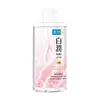What's inside
What's inside
 Key Ingredients
Key Ingredients

 Benefits
Benefits

 Concerns
Concerns

 Ingredients Side-by-side
Ingredients Side-by-side

Water
Skin ConditioningIsododecane
EmollientIsohexadecane
EmollientGlycerin
HumectantC12-15 Alkyl Benzoate
AntimicrobialIsopropyl Palmitate
EmollientPropylene Glycol
HumectantPropanediol
SolventSodium Chloride
MaskingRosa Damascena Flower Water
MaskingPhenoxyethanol
PreservativePolyaminopropyl Biguanide
PreservativeEthylhexylglycerin
Skin ConditioningZinc Hydrolyzed Hyaluronate
HumectantSodium Hyaluronate
HumectantDextrin
AbsorbentDisodium Phosphate
BufferingPotassium Phosphate
BufferingProtease
ExfoliatingLipase
Skin ConditioningBifida Ferment Lysate
Skin ConditioningPhospholipids
Skin ConditioningPhenethyl Alcohol
MaskingLactose
HumectantMilk Protein
Skin ConditioningPotassium Sorbate
PreservativeSphingolipids
EmollientSodium Citrate
BufferingWater, Isododecane, Isohexadecane, Glycerin, C12-15 Alkyl Benzoate, Isopropyl Palmitate, Propylene Glycol, Propanediol, Sodium Chloride, Rosa Damascena Flower Water, Phenoxyethanol, Polyaminopropyl Biguanide, Ethylhexylglycerin, Zinc Hydrolyzed Hyaluronate, Sodium Hyaluronate, Dextrin, Disodium Phosphate, Potassium Phosphate, Protease, Lipase, Bifida Ferment Lysate, Phospholipids, Phenethyl Alcohol, Lactose, Milk Protein, Potassium Sorbate, Sphingolipids, Sodium Citrate
Water
Skin ConditioningGlycerin
HumectantPEG-7 Caprylic/Capric Glycerides
EmulsifyingPropanediol
SolventPEG-6 Caprylic/Capric Glycerides
EmulsifyingSodium Cocoamphoacetate
CleansingChlorphenesin
AntimicrobialPEG/PPG/Polybutylene Glycol-8/5/3 Glycerin
HumectantXylitylglucoside
HumectantPolyaminopropyl Biguanide
PreservativeSodium Chloride
MaskingAnhydroxylitol
HumectantDisodium EDTA
Xylitol
HumectantSodium Hyaluronate
HumectantPhytic Acid
3-O-Ethyl Ascorbic Acid
Skin ConditioningSalicylic Acid
MaskingPotassium Azeloyl Diglycinate
Skin ConditioningAmylopectin
Dextrin
AbsorbentXanthan Gum
EmulsifyingButylene Glycol
Humectant1,2-Hexanediol
Skin ConditioningPhenoxyethanol
PreservativePentylene Glycol
Skin ConditioningPolyquaternium-10
Hydrolyzed Sodium Hyaluronate
Skin ConditioningMoringa Oleifera Seed Extract
Skin ConditioningBiosaccharide Gum-4
Skin ConditioningDisodium Phosphate
BufferingPotassium Chloride
Citric Acid
BufferingCaprylyl Glycol
EmollientWater, Glycerin, PEG-7 Caprylic/Capric Glycerides, Propanediol, PEG-6 Caprylic/Capric Glycerides, Sodium Cocoamphoacetate, Chlorphenesin, PEG/PPG/Polybutylene Glycol-8/5/3 Glycerin, Xylitylglucoside, Polyaminopropyl Biguanide, Sodium Chloride, Anhydroxylitol, Disodium EDTA, Xylitol, Sodium Hyaluronate, Phytic Acid, 3-O-Ethyl Ascorbic Acid, Salicylic Acid, Potassium Azeloyl Diglycinate, Amylopectin, Dextrin, Xanthan Gum, Butylene Glycol, 1,2-Hexanediol, Phenoxyethanol, Pentylene Glycol, Polyquaternium-10, Hydrolyzed Sodium Hyaluronate, Moringa Oleifera Seed Extract, Biosaccharide Gum-4, Disodium Phosphate, Potassium Chloride, Citric Acid, Caprylyl Glycol
Ingredients Explained
These ingredients are found in both products.
Ingredients higher up in an ingredient list are typically present in a larger amount.
Dextrin is used to thicken a product and helps bind ingredients together. It is created from starch and glycogen.
As an emulsifier, dextrin prevents ingredients from separating. This helps elongate a product's shelf life.
Studies show coating UV filters with dextrin prevents these ingredients from being absorbed. This helps UV ingredients last longer on the skin.
Learn more about DextrinDisodium Phosphate is a water-soluble powder used as a pH adjuster.
Glycerin is already naturally found in your skin. It helps moisturize and protect your skin.
A study from 2016 found glycerin to be more effective as a humectant than AHAs and hyaluronic acid.
As a humectant, it helps the skin stay hydrated by pulling moisture to your skin. The low molecular weight of glycerin allows it to pull moisture into the deeper layers of your skin.
Hydrated skin improves your skin barrier; Your skin barrier helps protect against irritants and bacteria.
Glycerin has also been found to have antimicrobial and antiviral properties. Due to these properties, glycerin is often used in wound and burn treatments.
In cosmetics, glycerin is usually derived from plants such as soybean or palm. However, it can also be sourced from animals, such as tallow or animal fat.
This ingredient is organic, colorless, odorless, and non-toxic.
Glycerin is the name for this ingredient in American English. British English uses Glycerol/Glycerine.
Learn more about GlycerinPhenoxyethanol is a preservative that has germicide, antimicrobial, and aromatic properties. Studies show that phenoxyethanol can prevent microbial growth. By itself, it has a scent that is similar to that of a rose.
It's often used in formulations along with Caprylyl Glycol to preserve the shelf life of products.
Polyaminopropyl Biguanide is a preservative.
Propanediol is an all-star ingredient. It softens, hydrates, and smooths the skin.
It’s often used to:
Propanediol is not likely to cause sensitivity and considered safe to use. It is derived from corn or petroleum with a clear color and no scent.
Learn more about PropanediolChances are, you eat sodium chloride every day. Sodium Chloride is also known as table salt.
This ingredient has many purposes in skincare: thickener, emulsifier, and exfoliator.
You'll most likely find this ingredient in cleansers where it is used to create a gel-like texture. As an emulsifier, it also prevents ingredients from separating.
There is much debate on whether this ingredient is comedogenic. The short answer - comedogenic ratings don't tell the whole story. Learn more about comegodenic ratings here.
The concensus about this ingredient causing acne seems to be divided. Research is needed to understand if this ingredient does cause acne.
Scrubs may use salt as the primary exfoliating ingredient.
Learn more about Sodium ChlorideSodium Hyaluronate is hyaluronic acid's salt form. It is commonly derived from the sodium salt of hyaluronic acid.
Like hyaluronic acid, it is great at holding water and acts as a humectant. This makes it a great skin hydrating ingredient.
Sodium Hyaluronate is naturally occurring in our bodies and is mostly found in eye fluid and joints.
These are some other common types of Hyaluronic Acid:
Learn more about Sodium HyaluronateWater. It's the most common cosmetic ingredient of all. You'll usually see it at the top of ingredient lists, meaning that it makes up the largest part of the product.
So why is it so popular? Water most often acts as a solvent - this means that it helps dissolve other ingredients into the formulation.
You'll also recognize water as that liquid we all need to stay alive. If you see this, drink a glass of water. Stay hydrated!
Learn more about Water